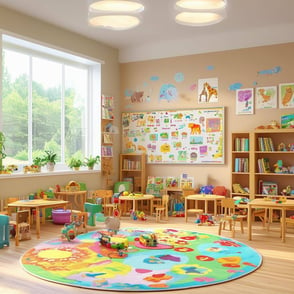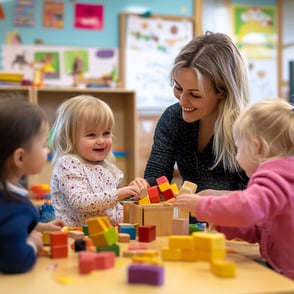A Lasting Influence on Early Childhood Education
Loris Malaguzzi, an Italian educator born in 1920, is renowned for revolutionising early childhood education in Europe and beyond. His pioneering work with the Reggio Emilia approach has left an indelible mark on educational psychology and theory, influencing pedagogical practices across the globe. In this blog, we will delve into Malaguzzi's history, training, key research, and the profound impact of his teachings, while also comparing and contrasting his work with other notable educators from the 20th century in the United Kingdom, Europe, and the United States.
But before you go on, take a look at our blogs on other early years educators and thinkers from across the US and Europe...
A Journey Through History and Training
Loris Malaguzzi's journey into the world of education began in the aftermath of World War II, a period marked by reconstruction and a fervent desire for societal transformation. Born in Correggio, Italy, Malaguzzi was initially trained as a teacher in 1939. However, his passion for child-centered education led him to pursue further studies in psychology at the University of Rome, where he graduated in 1946. This unique blend of training in both teaching and psychology laid the groundwork for his innovative approach to early childhood education.
After the war, Malaguzzi was drawn to Reggio Emilia, a small town in northern Italy, where parents were building schools from the rubble of their destroyed city. Inspired by their determination and collective spirit, Malaguzzi became integral to the development of educational practices that considered children as active participants in their own learning. His training and experiences coalesced into what is now known as the Reggio Emilia approach.
Key Research and Impact on Early Years Education
Central to Malaguzzi's philosophy was the belief that children are "rich in potential, strong, powerful, competent, and, most of all, connected to adults and other children." He advocated for a learning environment where children could explore, express themselves, and engage with the world around them. His approach was characterised by several key principles:
- The Image of the Child: Malaguzzi posited that children possess an inherent curiosity and capacity to learn. The Reggio Emilia approach nurtures this potential by involving children in decision-making processes and allowing them to lead their learning journeys.
- The Role of the Environment: Often referred to as the "third teacher," the learning environment in Reggio Emilia schools is carefully designed to inspire curiosity, creativity, and collaboration. This emphasis on the environment is akin to John Dewey's advocacy for experiential learning in the United States.
- Documentation as a Tool for Learning: Reggio educators meticulously document children's progress through photographs, videos, and written observations. This practice not only aids assessment but also encourages reflection among both educators and children, similar to the observational methods championed by Lev Vygotsky.
- Collaboration and Relationships: Malaguzzi saw learning as a social construct, much like Vygotsky's theories of social interaction. The Reggio approach emphasises collaboration among children, teachers, and parents, fostering a strong sense of community.
See how we've incorporated some of the principles of Reggio practice into all of our beautiful settings across London
The Mainstreaming of Malaguzzi's Teachings
Loris Malaguzzi's impact extends far beyond the borders of Italy. The Reggio Emilia approach gained international recognition in the late 20th century and has since influenced educational practices worldwide. In Europe, the approach aligns closely with constructivist theories, which emphasize hands-on, experiential learning. Its principles have been integrated into various curricula, particularly in Scandinavian countries, where child-centered education is highly valued.
In the United States, Reggio Emilia-inspired programs have sprouted in many preschools, offering an alternative to more traditional pedagogical methods. The approach's emphasis on creativity, critical thinking, and collaboration resonates with contemporary educational goals that prioritise 21st-century skills.
Contemporary Impact on Educational Psychology and Theory
Malaguzzi's influence is evident in contemporary educational psychology and theory. His belief in the child's potential aligns with modern understandings of the growth mindset, popularised by Carol Dweck. Furthermore, the Reggio Emilia approach's focus on social interaction and collaborative learning mirrors the principles of social constructivism and cooperative learning strategies.
The documentation practices of Reggio educators have also informed formative assessment techniques, encouraging educators to adopt a more holistic view of student progress. This approach aligns with the work of Howard Gardner, whose theory of multiple intelligences highlights the diverse ways in which children learn and express their understanding.
Comparing and Contrasting Educational Influences
To fully appreciate Malaguzzi's contributions, it is essential to compare his work with other influential educators and psychologists of the 20th century.
- Maria Montessori: Like Malaguzzi, Montessori emphasized the child's autonomy and the role of the environment in learning. However, while Montessori schools often employ a more structured approach, Reggio Emilia schools emphasize fluidity and flexibility based on children's interests.
- Jean Piaget: Piaget's theories of cognitive development share similarities with Malaguzzi's emphasis on active learning. However, Piaget's focus was primarily on stages of cognitive development, whereas Malaguzzi concentrated on the social and environmental aspects of learning.
- John Dewey: Dewey's philosophy of experiential learning is reflected in the Reggio Emilia approach's emphasis on hands-on experiences. Both educators believed in education as a tool for democracy and social change.
- Lev Vygotsky: Malaguzzi's emphasis on social interaction and community involvement resonates with Vygotsky's theories of social learning and the zone of proximal development. Both educators viewed learning as a collaborative process.
Lasting Legacy and Future Implications
Loris Malaguzzi's vision for early childhood education continues to inspire educators and policymakers worldwide. His ideas have reshaped our understanding of children's capabilities and the environments that best support their growth. As the world becomes increasingly interconnected, the emphasis on collaboration, creativity, and critical thinking in the Reggio Emilia approach remains relevant in preparing children for the challenges of the 21st century.
In conclusion, Loris Malaguzzi's enduring legacy lies in his unwavering belief in the potential of every child. His teachings have not only become mainstream in Western pedagogy but have also enriched the field of educational psychology and theory. By fostering environments that celebrate curiosity and collaboration, Malaguzzi has provided a blueprint for educators seeking to empower the next generation of learners. As we continue to explore innovative approaches to education, the principles of the Reggio Emilia approach offer valuable insights into nurturing the minds of young children in an ever-changing world.

01-Jan-2025 19:57:34
Related Articles








Write a Comment